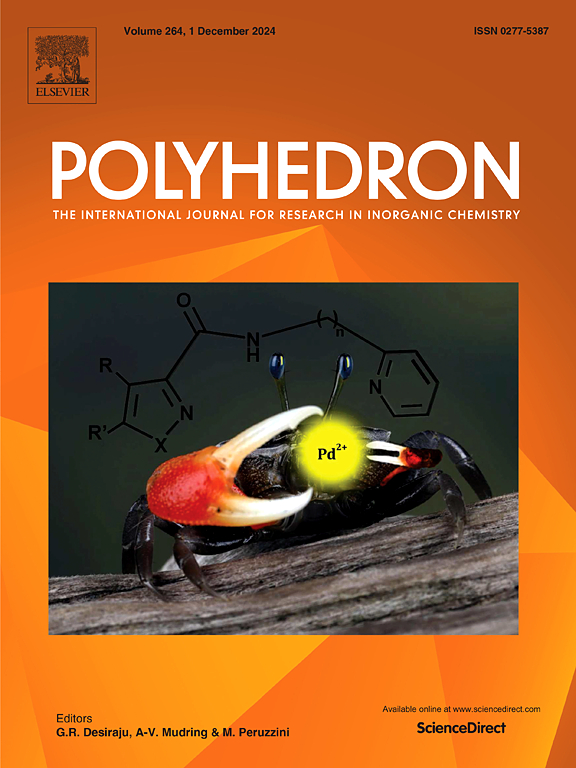双(亚氨基)膦 [NPN] 配体及其卤化铜(I)配合物的合成与表征
IF 2.4
3区 化学
Q2 CHEMISTRY, INORGANIC & NUCLEAR
引用次数: 0
摘要
合成了一系列四种新的双(亚氨基)膦[NPN]配体 PhP(C6H4-2-HC=NAr)2(Ar = 4-OMeC6H4 (L1, 1)、4-ClC6H4 (L2, 2)、4-BrC6H4 (L3, 3)、2,6-iPr2C6H3 (L4, 4)),并对其进行了结构表征。探讨了它们与 Cu(I)卤化物 CuX(X = Cl、Br、I)的反应,以组装配位配合物 LnCuX,并比较研究了取代基(Ar)和阴离子(X)的影响。研究发现,甲氧基取代的 L1(Ar = 4-OMeC6H4)与 CuX 反应生成具有等结构特征的单核 Cu(I)配合物 L1CuX(X = Cl (1a)、Br (1b)、I (1c))。相反,当使用卤素取代配体 L2-3(4-ClC6H4、4-BrC6H4)时,无论反应物的组成如何,它们与 CuCl 反应都会形成由 Cu2Cl2 方桥连接的四核二聚体 [Ln(CuCl)2]2 (n = 2 (2a)、3 (3a))。另一方面,L2-3 与 CuBr 和 CuI 反应再次生成单核 Cu(I)配合物 LnCuX(n = 2,X = Br (2b),I (2c);n = 3,X = Br (3b),I (3c))。在上述所有情况中,L1-3 配体通过 NPN 位点咬合铜(I)中心,发挥了三位一体的作用。当涉及到大块 L4(Ar = 2,6-iPr2C6H3)时,就得到了由碘阴离子桥接的双核二聚体 (L4CuI)2 (4c),其中每个 L4 配体都通过双齿 P^N 模式与另一个亚氨基臂悬垂配位铜中心。在进一步的探索中,引入了 1,10-邻菲罗啉(表示为 phen),生成了异极配合物 L1CuCl(phen)(1d),其中 L1 中的两个亚氨基臂都是悬垂的。获得的配体(L1-4)和 Cu(I)配合物通过熔点、元素分析、傅立叶变换红外光谱、紫外可见光谱、核磁共振和单晶 X 射线衍射进行了表征。本文章由计算机程序翻译,如有差异,请以英文原文为准。
![Synthesis and characterization of Bis(imino)phosphine [NPN] ligands and their copper(I) halide complexes](https://img.booksci.cn/booksciimg/2024-10/99294787341760022837.jpg)
Synthesis and characterization of Bis(imino)phosphine [NPN] ligands and their copper(I) halide complexes
A series of four new bis(imino)phosphine [NPN] ligands PhP(C6H4-2-HC=NAr)2 (Ar = 4-OMeC6H4 (L1, 1), 4-ClC6H4 (L2, 2), 4-BrC6H4 (L3, 3), 2,6-iPr2C6H3 (L4, 4)) were synthesized and structurally characterized. Their reactions with Cu(I) halides CuX (X = Cl, Br, I) were explored for the assembly of coordination complexes LnCuX, and the effects of substituent (Ar) and anion (X) were also investigated in a comparative manner. It was found that the reaction of methoxy substituted L1 (Ar = 4-OMeC6H4) with CuX gave the mononuclear Cu(I) complexes L1CuX (X = Cl (1a), Br (1b), I (1c)) with isostructural feature. In contrast, when halogen-substituted ligands L2-3 (4-ClC6H4, 4-BrC6H4) were applied, their reactions with CuCl afforded the formation of tetranuclear dimer [Ln(CuCl)2]2 (n = 2 (2a), 3 (3a)) bridged by the Cu2Cl2 square, regardless of the composition of the reactants. On the other hand, reactions of L2-3 with CuBr and CuI generated the mononuclear Cu(I) complexes LnCuX (n = 2, X = Br (2b), I (2c); n = 3, X = Br (3b), I (3c)) again. In all these cases above, L1-3 ligands played the tridentate role by biting the copper(I) centers through NPN sites. When the bulky L4 (Ar = 2,6-iPr2C6H3) was involved, the binuclear dimer (L4CuI)2 (4c) bridged by iodide anions was obtained, where each L4 ligand coordinated the copper center using the bidentate P^N mode with another imino arm pendant. In further exploration, 1,10-o-phenanthroline (denoted as phen) was introduced to produce the heteroleptic complex L1CuCl(phen) (1d), where both imino arms in L1 were pendent. The obtained ligand (L1-4) and Cu(I) complexes were characterized by melting point, elemental analysis, FT-IR, UV–Vis, NMR, and single crystal X-ray diffraction.
求助全文
通过发布文献求助,成功后即可免费获取论文全文。
去求助
来源期刊

Polyhedron
化学-晶体学
CiteScore
4.90
自引率
7.70%
发文量
515
审稿时长
2 months
期刊介绍:
Polyhedron publishes original, fundamental, experimental and theoretical work of the highest quality in all the major areas of inorganic chemistry. This includes synthetic chemistry, coordination chemistry, organometallic chemistry, bioinorganic chemistry, and solid-state and materials chemistry.
Papers should be significant pieces of work, and all new compounds must be appropriately characterized. The inclusion of single-crystal X-ray structural data is strongly encouraged, but papers reporting only the X-ray structure determination of a single compound will usually not be considered. Papers on solid-state or materials chemistry will be expected to have a significant molecular chemistry component (such as the synthesis and characterization of the molecular precursors and/or a systematic study of the use of different precursors or reaction conditions) or demonstrate a cutting-edge application (for example inorganic materials for energy applications). Papers dealing only with stability constants are not considered.
 求助内容:
求助内容: 应助结果提醒方式:
应助结果提醒方式:


